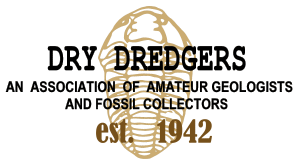The Walcott-Rust quarry (a creek exposure in New York) is a classic Ordovician site. Much has been written about it and the famous Charles Doolittle Walcott who made major discoveries based on the specimens he collected there in the mid-to-late 1800s. His work focused on the fossils that the locality has long been famous for: its trilobites.
But the strata also contain several echinoderms. Among them are crinoids along with occasional starfish, and rare cystoids and cyclocystoids.
A decade ago, I had the opportunity to collect at the site with Dan Cooper, who had just leased the fossil collecting rights from the property owner. I was aware that echinoderms could be found there, but did not expect to find something as rare as a starfish. And, of course, I didn’t. Not on any of the several collecting trips to the quarry. But I did acquire two specimens from Dan’s son Jason, who was digging the site regularly. The first starfish specimen occupies the same small slab with a crinoid (Figure 1).

The starfish is unusual because one arm is missing. The arm was not lost when collected or during prep. It simply wasn’t there. This suggests it was lost back in the Ordovician (“natural damage”), during burial or perhaps due to attack by a predator, or possibly that the arm never developed (a “pathological” specimen).
The other starfish was on a large partially prepped slab from the quarry. I held onto it for several years before finally asking Ben Cooper to do the finish prep. That prep work revealed that the slab also contains two small trilobites. The end result is in Figure 2.

At over two and a half inches across, this starfish is a large specimen. A close-up view is in Figure 3.

A question for those reading this blog: Does anyone out there have identification for these starfish?
[I wrote a more comprehensive article on my experiences at the Walcott-Rust site for the 2020 MAPS Expo Digest. But since the 2020 MAPS Show was cancelled due to Covid-19 concerns, the publication date has been postponed until the next show in spring 2021.]
Don Bissett

A long-time member of the Dry Dredgers, I’ve been collecting fossils ever since moving to Cincinnati in 1975 to work at P&G. I was introduced to fossil collecting by Bruce Gibson, another Dry Dredger and co-worker at P&G. Shortly after that, I met Dredger Dan Cooper. Both of them taught me a lot about the hobby. Ever since, I’ve been hooked on fossils.
My primary focus is collecting trilobites and echinoderms, though I often find myself accumulating a much wider assortment of fossils. Beyond the collecting hobby, I’ve also had the opportunity to work with professional paleontologists – extremely rewarding experiences. Some of those have been described in Dry Dredger Bulletin articles, MAPS (Mid-American Paleontology Society) articles, and technical publications. I plan to share more about collecting and professional interactions in my blog posts.Latest posts by Don Bissett (see all)
- Massie Shale Calymene - January 4, 2021
- Mississippian starfish - November 13, 2020
- Walcott-Rust Starfish - October 25, 2020
- Spathacalymene - September 20, 2020
- Penn Dixie Dig with the Experts 2018 - May 27, 2018





Don
The best single reference is SMITHSONIAN INSTITUTION UNITED STATES NATIONAL MUSEUM
Bulletin 88 which is Schuchert’s “Revision of Paleozoic Stelleroidea with special refereance to North American Asteroidea,” Its readily available on the internet as a pdf copy. You can also find hardcopies on the Internet as well at Abebooks. Other sources include Journal Paleontological papers by Thomas Guensburg, Daniel Blake, and Fred Hotchkiss,
I had about 35 starfish in my collection at one time. Species include:
Promopalaeaster magnificus
Promopalaeaster speciosus
Urasterella grandis
Promopalaeaster finei
Hudonsaster incomptus
Protasterina flexuosa
Taeniaster flexuous
Asteriacites stelliforme
Stenaster salteri
Mesopaleaster sp
Protasterina fimbriata
I may still have photos with ID. Another source for info is Steve Holland’s website. Let me look around and I see what I have, It might take me awhile.
steve brown
Dry Dredger
Steve: Thanks so much for the information! This is fantastic! Don
Don
Figure 2/3 is probably the genus Urasterella
Don
Fig 2 starfish shown at https://trenton.mcz.harvard.edu/echinodermata
steve
Hello Don! There is also David Blake’s : Blake, D. B. 2018. Toward a history of the Paleozoic Asteroidea (Echinodermata). Bulletins of American Paleontology No. 394, 96 pp., 15 pls. Purchase. At PRI Bookstore. We are presently working on describing starfishes from the Neuville Formation of Quebec (similar in age with the Rust Formation), and we do have a couple of specimen that looks like the one on the second (and third) photos… This probably new!
BTW, the small crinoid looks like a Cincinnaticrinus…
Mario: Thanks for the reference. Look forward to learning more about your work on the Neuville Formation. And thanks for the ID on the crinoid. Don